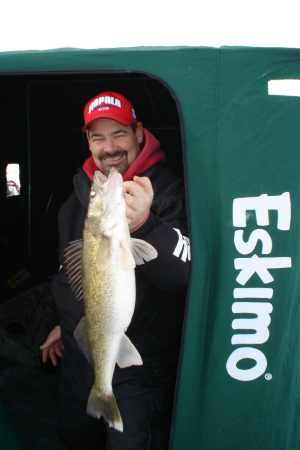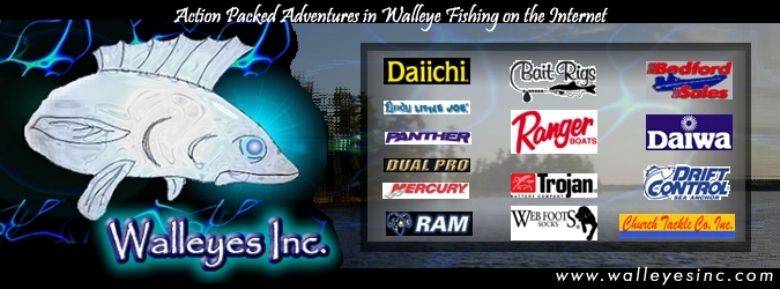|
Icing big walleyes on big reservoirs is big fun, without
a doubt. Lakes like Oahe and Sakakawea in North and South
Dakota are good examples, and are loaded with walleyes. Anglers
working the ice early in the season can make some astounding
catches, and better yet they can do it during banker’s
hours!
The mid day pattern doesn’t really fit with natural
lakes which usually see more activity at sunup and again at
sundown, and even after dark. But reservoirs aren’t
natural; they’re manmade, and have their own unique
characteristics. That doesn’t mean lowlight patterns
won’t produce, they will. It’s just that early
on you can usually find plenty of active fish in the middle
of the day. As the season progresses and early ice is long
gone you can then expect to find most of the activity surrounding
the periods of early morning and just before and just after
dark.
Location is the key to it all and if you can find them you
will probably catch them. Reservoir walleyes can be more than
agreeable; you just have to be on ‘em. There is a rule
of thumb that includes walleyes moving upstream during the
fall period where they will stay for the winter which puts
a lot of fish in the upper reaches of a reservoir. On Oahe
it’s the Pollock and Mobridge area, on Sakakawea it’s
the VanHook arm and above. Even though it does happen, not
all of the fish make the move. There’s always some that
stay home in the lower end of a reservoir and are still quite
catchable, it’s just that the sheer numbers can make
the top end a lot more productive. Lake Sharpe is an exception
to the rule of thumb as most of the ice angling takes place
on the bottom end of the reservoir, but the lakes not near
as big or deep as Oahe or Sakakawea.

Rick Olson was on the clock for this big early ice
walleye |
Another rule of thumb is to look for fast breaks, but
there’s really more to it. When you start your search
take a look at the major feeder creek and river arms and
then try and find the fast breaks in conjunction with
a feeding shelf or flat area. It could be the top of an
underwater bar, a hump, or a shelf in the middle of creek
arm. A fast break where contour lines pull together nice
and tight indicates the sharpest drop off and is good
spot to start looking for fish. A good map is a must for
finding potential hot spots quickly. The best case scenario
includes a high definition electronic map lake the Navionics
HotMaps, combined with a G.P.S. that can display the info
on a plotter. My four wheeler has a Raymarine 425 mounted
on the handle bars and display the Navionics maps which
make finding what I’m looking for a whole lot easier.
It saves a lot of valuable time that can be spent in more
productive ways, like hooking and landing big fat walleyes
In South Dakota we can use up to four lines through the
ice, which gives us flexibility and the ability to cover
a lot of water at the same time. My typical set includes
putting out at least two tip-ups on areas where I think
there might be fish, and then setting up on the hottest
spot and using a spoon with one rod and a bobber and minnow
on the other. |
My bobber and minnow rig is simple enough and has a split
shot and a small treble that’s hooked through the dorsal
fin of a big fathead. The spoon is typically 1/4oz to maybe
3/8oz, depending on how deep I’m fishing. The deeper
you go the more weight you’ll need with idea being to
go as light as you can while still being able to get the job
done.
A depth finder can be a big help in determining the actual
depth and for watching fish and how they react to your bait,
but when you get far enough up a reservoir you can run into
too much current. Reservoirs like Oahe run water all winter
long to produce power, and there’s always current to
be aware of and to deal with. Current can move your bait out
of the cone angle of a depth finder and push your bait up
off the bottom. Tip-up sets will have to be dropped to the
bottom and then dropped again after they settle out to set
them at the proper depth. The key is keeping the bait close
to the bottom without actually being on it.
Besides not being able to keep a bait right below a hole,
safety also is a concern. Before you head out make sure you
know exactly what you’re doing and don’t take
any chances. Get as much info as you can, especially from
any of the local bait shops.
While a lot of reservoir anglers use nothing but tip-ups,
I still like to have a rod in my hand and work a jigging spoon.
Jigging spoons get noticed and can attract fish from a greater
distance than a set rig. It’s also the excitement of
actually feeling the bite, and not just setting the hook.
Besides, you can still have two or three tip-ups out. By covering
multiple depths and using a couple of different presentations
you can find out exactly what the walleyes are looking for.
You can also see how a school of fish moves as the first flag
goes, and the next, and then your spoon gets hit. When it
happens you’ll be plenty busy, and when the fun really
begins.
Rick Olson
|

